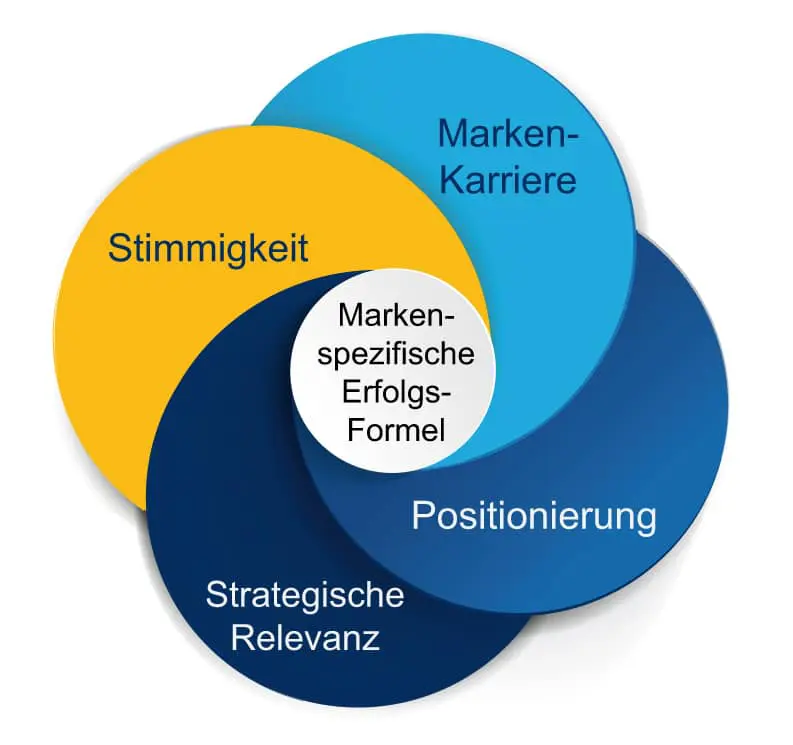The Brand Success Code is the key to relevance
Over the past 20 years, rheingold has identified five key factors determining a brand’s success. The starting point for successful brand management is to identify the strategic relevance of a brand. Coherent brand management can be impactfully facilitated by understanding the rules that determine the dynamics within the market or category. Since every market is unique, universal brand management models are often not helpful.
It is strategically important to gather specific knowledge of the unique drivers and impacting (hi)stories that impact the respective market: What moves and motivates consumers in my market or category? What forces influence consumer behavior? And which factors, including psychological ones, determine their purchasing decisions? The answers are illustrated by a strategic functional model of the specific category. This creates a unique strategic basis that shows the category’s inherent relevant levers and influencing factors.,enabling a precise description of the function of a brand and its strengths and weaknesses.

Sparkling wine brands as mood changers
A sparkling wine brand such as “Freixenet”, for example, is subject to the category laws of changing moods. Sparkling wine brands are supposed to lift spirits. However, this function can play out in very different directions: Brands like “Fürst von Metternich” or “Henkell Trocken” are supposed to conserve a situational high. Festive or crowning moments - awedding, a birthday or an anniversary - are to be captured, stopped and cast in amber, so to say. This kind of uplifting of spirits, however, requires the sparkling wine to be very sophisticated and distinguished. The sparkling wine should not break completely break out of the ordinary, but remind of the right “etiquette”. However, sparkling wine also has another, frothy and disinhibiting side.
Unleashed cork popping
The popping of the corks is a signal that our urges and desires can be unleashed for once. This tingling release side of sparkling wine is well embodied by the “Freixenet” brand. It doesn’t as much promise the preservation of a beautiful moment, but the gliding over into a freer and more sensual mood. “Freixenet”'s brand-specific formula for success is the "release of cultivated sensuality." This also defines the three key moments of success for the brand: it acts as a transitional supporter and helps us escape the linearity of everyday life. It lets us feel more sensual and acts as a social lubricant that can even extend into flirting or a sensual approach.
However, it is and always remains cultivated and stylish. Freixenet does not allow vulgarity or coarseness as downsides of alcoholic unleashing. The brand-specific success formula is the second success factor of a brand. This formula is not to be confused with the claim or slogan. Rather, it condenses the deep dimensions and the secret message of a brand, which is decoded with the help of rheingold interviews.
The harmonious overall picture
The third success factor is the coherence of a brand. Since brands can be understood as personalities, it is essential that they convey a coherent overall image in all the ways they express themselves towards consumers: The product has to deliver on what advertising and packaging promise.The credibility of a brand depends crucially on whether it succeeds in conveying an organic overall picture across all its touchpoints - from the appearance on Facebook to the call center.
This does not mean perfection in all components, but a harmonious fit overall. In the case of “Freixenet”, coherence is ensured when the brand fulfills a triad across its expressions, which is already echoed in the name: Free X Nice.
Mysterious magic
The liberating effect of the brand is ideally always sensually experienced in the music, atmosphere, and tonality surrounding “Freixenet”. Galloping horses, racy guitar sounds or the opening rose are important release signals of Freixenet. But the brand must also always appear cultivated and sophisticated. Therefore, a certain formal rigor in the design of advertising measures is just as important as the high-quality bottle design. Between these poles, however, the brand always unfolds a mysterious magic that is conveyed by theconnecting X. The change of mood with “Freixenet” remains in a tingling limbo.
Sparkling wine-enabled courage
The strategically relevant formula for success as well as its coherence, help a brand succeed in establishing a unique positioning in the category. “Freixenet”'s promise not only sets it apart from the mood lifting brands already described, such as “Henkell Trocken” or “Fürst von Metternich”, but also from breakthrough brands like “Mumm” or “Deinhard”. These brands promise to break through one's stuckness and help develop courage. The legendary ecstatically drumming Deinhard woman in a purple dress eruptively calling for the Deinhard epitomizes the cork popping moment that sparkling wine evokes.
Goal-oriented navigation of a brand
Strategic brand management needs maps of the category that are true to scale for target-relevant navigation. Ideally, these maps not only show the psychological USP of the brand in question, but also the positions of and potential threats competitors may pose.
Our maps in addition include an outlook of future development opportunities of brands. The fifth success factor is the career of the brand. Brands are not static, but continue to develop. They develop throughline extensions, or conquer entirely new categories with their formula for success.
Brand Success Code as a principle of success
Successful future management of a brand naturally depends on knowing its Brand Success Code. A brand can then capitalize on its success principle even in completely new markets. For the Freixenet brand, stylish flowers or gift services, romantic trips for couples, or a racy lingerie collection could be options worth examining for expanding its passionate, elegant transitional aid.
Spatial digitization is changing the world, people and marketing. It has far-reaching consequences for markets, for consumer behavior, customers' media use, their purchasing decisions and habits. The reality of our lives is becoming more fluid. Structures and boundaries are becoming blurred, everyday life, professional life and relationships are becoming more flexible, media use is becoming fragmented and business is becoming globalized.




